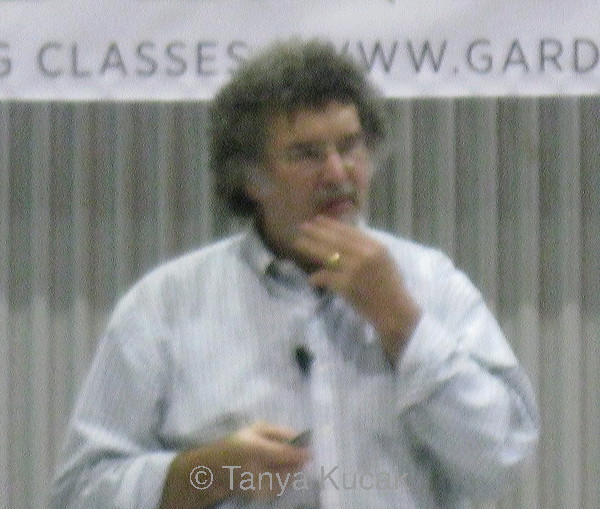
One of the new features at this year's San Francisco Flower and Garden Show is the photo seminars. If you want to share features of your garden with distant friends and relatives, it helps to understand the 2-D world of the camera.
Saxon Holt talked about the “meditative process of photography” and showed photos to illustrate the six lessons in his ebook Think Like a Camera.
Framing. “Find stories you like in the garden” and frame a picture. “Use all edges of the frame,” he said. Use elements at the edge of a photo to “keep the eye in the frame so it doesn't wander off.” An out-of-focus foreground can be a framing device, and so can a brighter area in the center of the frame. Light colors draw the eye in. Use a tripod; it will force you to “stop and look through the viewfinder.”
Focal Point. Find the point of the picture. “Where do you want the viewer's eye to go?” Use the rule of thirds to make the image more pleasing to look at. If you divide a rectangle in thirds in both directions, the intersection of the lines gives you four “sweet spots.” An image placed at these points creates a more harmonious composition. But also, Holt said, “break all the rules and do crazy things so you learn.”
Leading Lines. To give the viewer a sense of discovery, look for pathways and walls in the garden, and use them to guide the viewer's eye. Placing leading lines at an angle “pulls the viewer into the picture.”
Point of View. What is your story? From what vantage point are you inviting the viewer into the garden? If you're not “finding the shot,” Holt said, change your point of view physically: get a ladder, or get down to ground level. For instance, look at flowers from ground level, “in relationship to the earth,” to see the stems.
Space and Shape. “What makes a strong photo is how you use space and shape within it.” The shapes fit together like a jigsaw puzzle, Holt said. All the shapes in a photo make a harmonious whole, including negative space.
Vignettes and Details. Tell “little stories” by focusing on details.
Another photographer at the show, David E. Perry, talked about iPhone and iPad photography. Why carry around a heavy camera with special lenses, he said, and instead use the “amazing, always-with-you” camera that (assuming you have an iPhone, iPad, or Android smartphone) is already at hand?
A way to hold the device more securely is the most important add-on, he said. Perry recommended the $20 Gorillapod with a GripTight mount for the iPhone, or a $15 Grifiti Nootle to attach an iPad. “Fancier ones don't work as well,” he said. He uses an earbud as the cable release.
The only add-on lenses worth using (“that aren't crap”) are made by Moment, about $100 each. With the 18mm, you can focus 1.5 inches away; the 60mm is “like a short telephoto.”
His number-one favorite app to shoot with is Camera+. He also likes PicsArt (to add effects) and Over (to put text on images). In addition, Photoshop Touch is a $10 app for phones or tablets. “Start with good pictures,” Perry said.

David Perry talked about photography using an iPad, iPhone, or other mobile device.

Overcast days offer even light, with no shadows. Next best is early morning or late afternoon, when the light isn't as harsh as in midday. Backlighting and late afternoon sun can spotlight features such as these native grasses, catching the light.

Placing the image off center makes a more interesting photo. This squirrel was looking for snacks in the middle of Washington, D.C.

Before you take a photo, think about where you want to focus the viewer's attention. What is your point of view?

Saxon Holt's website, photobotanic.com, offers workshops on garden photography.

Focus on interesting details, such as the chewed-on petals of this flower or its visitor. Taking a break to look at just one thing is like sitting on a bench in the garden after running around.
© 2015 Tanya Kucak